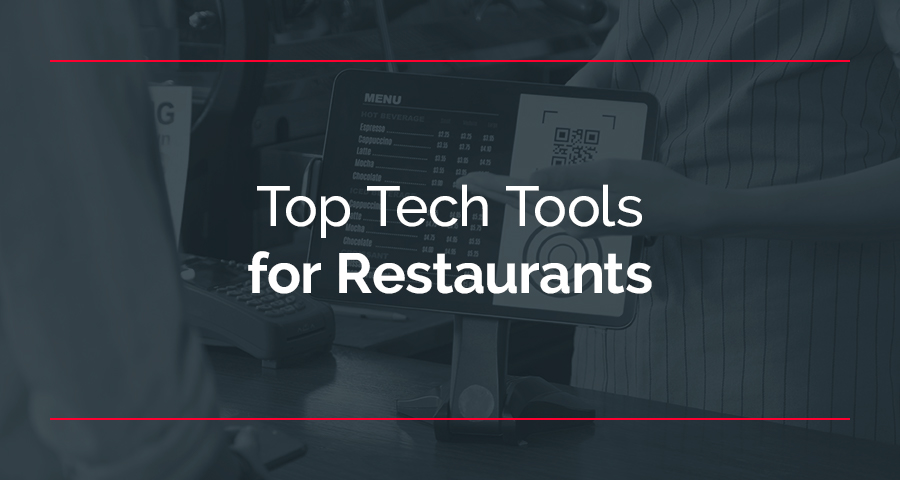Since the pandemic has allowed the restaurant industry to expand its services, the food and beverage sector has improved from traditional methods to modern and digitized solutions. Several brands have incorporated technology to enhance the experience of customers, which has created convenience and novelty for the whole industry. From online ordering to contactless payment, technology has now become an integral part of the restaurant industry.
Essentially, technology has given restaurants a way to thrive in a competitive market. These innovations are allowing restaurant owners to reinvent their services and remain relevant in the space while meeting customers’ ever-changing needs. Staying updated on the preferences of the customers is essential to growing in the sector, and restaurant tech tools can enable business owners to deliver on their customer’s expectations.
Here’s an in-depth look at the top tech tools for restaurants today.
New Technology for Restaurants to Consider
There are endless tech opportunities for restaurants to pursue, from delivery apps to management software and everything in between. These options help food and beverage business owners streamline their processes so they can better serve their customers. Additionally, tech allows restaurants to be on the cutting-edge, which many younger customers prefer. In light of COVID-19, restaurants may want to explore tech to stand out and drive business.
Check out seven tech options for restaurants.
1. Online Ordering and Delivery Apps
The imposed restrictions amid COVID-19 have allowed restaurants to provide service within imposed restrictions. As a result, most restaurants have relied strictly on takeout and delivery orders to make money. It’s no surprise that online ordering and delivery apps have exploded in popularity. These systems allow restaurants to continue serving customers in some capacity while prioritizing employee and customer safety.
Many diners also prefer this change, as they get their favorite dishes at home without spending time in long lines. Additionally, they can use one app to browse several restaurants, allowing them to pick and choose what they want to eat in mere minutes. Convenience also plays a role, since many customers don’t want to leave their homes to dine out.
Ultimately, food delivery apps improve connections between restaurants and customers while allowing restaurants to stay in business.
2. Contactless Payment
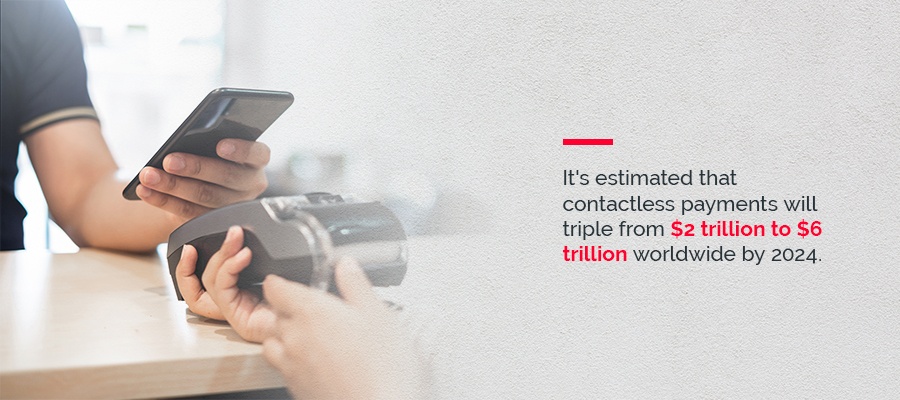
Another trend gaining momentum is contactless payment. It’s not limited to online orders — anyone can pay with a gadget like a smartphone or smartwatch, even in-person at a checkout counter.
It’s estimated that contactless payments will triple from $2 trillion to $6 trillion worldwide by 2024. Having these payment options is extremely important for customers, as contactless payment is easier and safer in most situations. It also has a positive impact on the cash flow of the restaurants. If you offer more ways for your customers to pay, you open the door for more payments.
3. Online Table Reservation Systems
Calling restaurants to make a reservation has become somewhat obsolete after the introduction of online booking, where customers use an online system or an app to select a table with a time and date. This tech provides plenty of convenience for customers. They can make reservations far in advance for large parties without needing to call. Additionally, customers often have a way to adjust their reservations when necessary.
This type of restaurant technology is also beneficial for restaurants. These establishments can manage seating, create waiting lists and even boost customer loyalty. This tech also enables them to understand the dining preferences of customers and collect client data for market insights and contact tracing. As a result, restaurants have a unique opportunity to meet customer needs before customers even voice them.
Along with offering tables, restaurants can also add information about upcoming events on the platform. This way, customers can ask questions and book seats at culinary events. These possibilities give creative freedom to many restaurants.
4. Digital Kitchen Boards
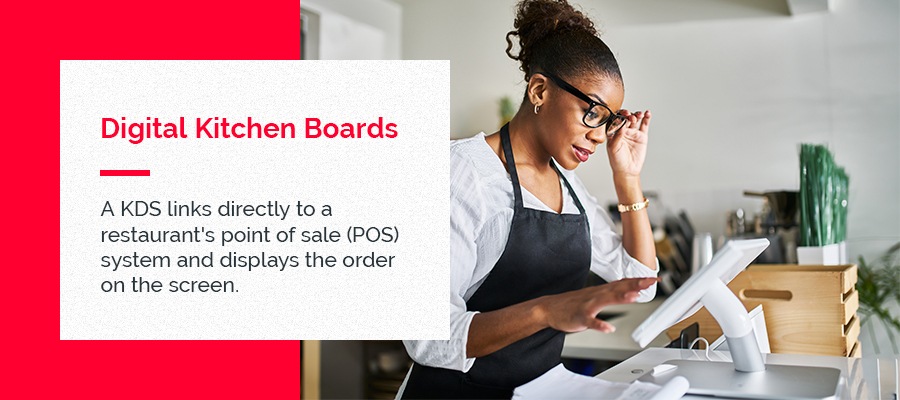
Sometimes, chefs and kitchen staff have to grab pen and paper to write orders down, or they print orders on receipts. This back and forth can result in lost tickets and a lack of organization. To help restaurants streamline kitchen service, they can use kitchen display systems (KDS), which are essentially digital menu boards.
A KDS links directly to a restaurant’s point of sale (POS) system and displays the order on the screen. The order is displayed according to priority and includes customers’ dietary requests, as well. This system tracks meal delivery times and also monitors inventory to indicate when a product is out of stock.
This advancement can help provide better communication and improve accuracy and workflow in restaurants. Since KDS are fully digital, they promise more sustainable kitchen operations, as well.
5. Automated Inventory Management Software
This restaurant technology has been helpful for better inventory management. By automating inventory management, you can save a lot of time on mundane tasks like tracking food and beverage stock, anticipating quantities and scheduling reorders. The incorporation of inventory management software in restaurants can also reduce food waste, helping the food and beverage sector save billions.
6. QR Codes
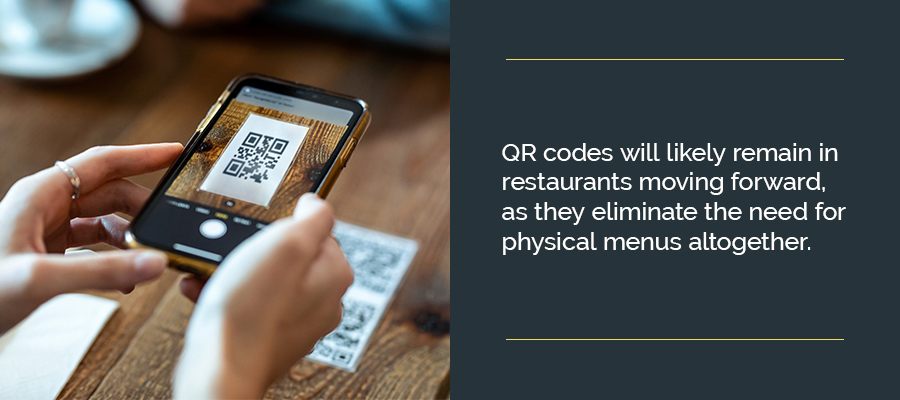
QR codes enable customers to access online menus, place orders and pay via their devices. Rather than hand out menus to every customer who walks in the door, restaurant workers can simply display QR codes on tables or near order counters and direct customers to scan the image with their smartphone.
Regarding COVID-19, QR codes allow for a safer restaurant environment for everyone. However, QR codes will likely remain in restaurants moving forward, as they eliminate the need for physical menus altogether. Instead of paying money to print menus, restaurants can simply upload them in the form of PDFs. As a result, people who want to order online can access them, and those in the restaurant can find them through the QR code.
The best part is customers don’t have to download any special applications on their phone, as they just need their camera to access the link.
7. Air Purification and UV Sanitation
These days, more people are concerned about their health for clear reasons. Even when COVID-19 isn’t a threat in the coming years, it’ll still be important for restaurants to prioritize customer safety — and a clean, purified environment is paramount. As a result, some restaurants are relying on air purification tech so they can keep serving customers inside.
This technology purifies the air in indoor spaces by neutralizing contaminants. For sanitation purposes on tables and other surfaces, some devices use ultraviolet (UV) rays, which helps reduce the need for specific cleaning products. As a result, employees can save time. These tech tools are on the rise in the food and beverage sector, especially as some customers may only want to eat at or order food from restaurants that use these devices.
Examples of Top Tech Tools Restaurants Are Using Today
Alongside the above restaurant technology trends, you may want to explore a few examples of tech tools restaurants have employed in their businesses.
1. Waitrainer+
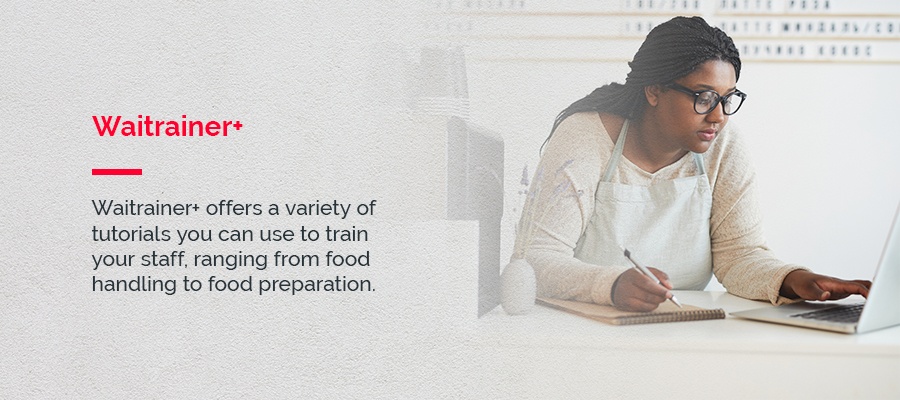
In a constantly evolving market, having a skilled staff is a game-changer. After all, employees should have the right knowledge to keep up with the dynamic needs of customers. Waitrainer+ offers a variety of tutorials you can use to train your staff, ranging from food handling to food preparation. This platform also offers a training plan that suits each employee’s schedule, allowing them to train online anywhere, anytime.
2. Preferred Patron
Rewarding customers for their loyalty will encourage them to visit your restaurant often. Through a loyalty program like Preferred Patron, you can set up deals and rewards programs specifically for your customers. Additionally, you can customize how you want to present the offers, whether that’s through social media or another avenue. As a result, you get to increase customer engagement and retention.
3. Upserve
In modern times, online ordering has become essential. Many customers prefer to place their orders online, so several restaurants offer online ordering to their customers. If you’re looking to build an online ordering platform for your customers, you could try using Upserve, an online ordering system that has numerous features — mobile applications, payment services and POS systems. It comes with a customer database, menu analytics, server performance, voided transactions and brand reputation evaluation.
4. CAKE

CAKE is also an online ordering system, and it comes with a reporting module, so you’ll be able to see sales reports quickly and in real-time. This program also assists restaurant owners in monitoring employee performance, like the number of work hours and overtime shifts.
5. TouchBistro
TouchBistro is a POS solution that can improve customer satisfaction, allowing customers to place orders right from their table. Therefore, customers don’t have to wait for a server. This restaurant technology can make it easier for restaurant owners to offer new selections, and even highlights some of the items on the menu. TouchBistro also makes it simple for the guest to split or merge their checks. Remember, the more flexible and accommodating you are when it comes to paying, the more likely your customers will want to come back.
Ideas for Improving Restaurant Customer Service With Technology
Most restaurant owners know that customer needs can change at a moment’s notice. These days, customers want convenience — and technology can assist businesses in improving their customer service. The plethora of new tech tools for restaurants can help them train employees better, meet customer needs and more. The result is a whole new experience for customers.
1. Offer Consistent Training for Staff
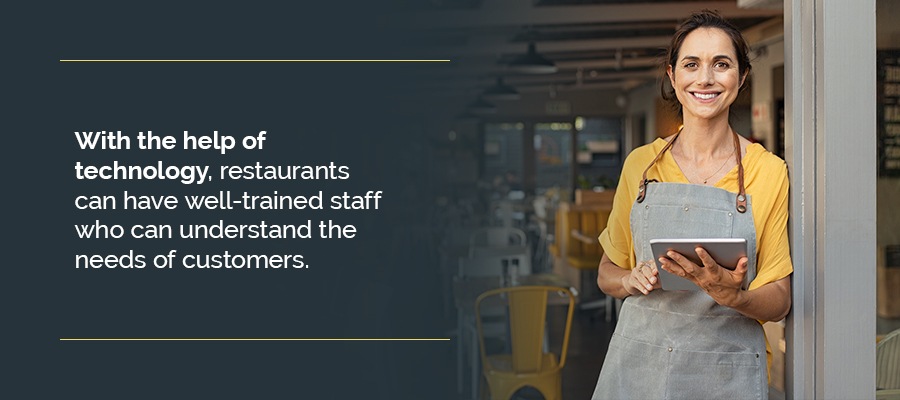
The restaurant business is competitive — and to stay on the top of the game, skilled staff is essential. But sometimes, servers leave as quickly as they come, so providing proper training to new staff can be challenging, especially when you have a business to run. Platforms with videos and tutorials can be a significant help in these situations.
This restaurant technology takes the stress out of training and offers a consistent regimen for all new staff. As a result, servers and bartenders don’t have to hang around after their shifts to receive training. Instead, they can take the tutorials online. It’s also possible to customize training technology for your specific needs. If you’ve seen trends that indicate you need to focus on a specific area, you can likely do so.
With the help of technology, restaurants can have well-trained staff who can understand the needs of customers, in turn enhancing profitability.
2. Let Customers Text the Manager
Most customers prefer to leave a negative review online than talk with the manager to discuss their complaints, which can affect the image of your restaurant and decrease your profits. Many customers avoid voicing their opinions altogether, instead choosing to keep their thoughts to themselves. No matter how they go about their issues with your restaurant, they’ll likely never come back.
A tech solution for that problem is to let customers text the establishment’s manager. Being able to leave an anonymous review via text helps them save time, and they can rest assured that a person in charge actually sees their message. Additionally, managers can tackle immediate situations as they arise, rather than going online and coming across a problem that happened weeks ago.
For example, a customer who goes back to their car after eating can take a few seconds to pass along a note about the quality of the service. The manager can send back a reply and quickly make changes to address the issue. Then, the customer actually feels like they got somewhere, and they’re more likely to return the next time they want to eat out for dinner.
3. Build a Better Loyalty Program
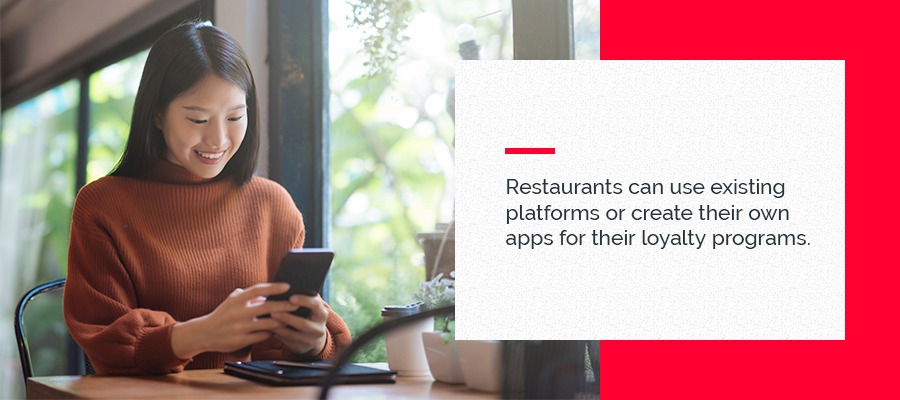
A loyalty program can help increase how often customers come back to visit your establishment. Some businesses still offer loyalty cards and coupons, which are effective, but you could try out mobile apps instead. This way, your customers won’t have to worry about losing their cards. Plus, it’s more convenient, as most people bring their phones to restaurants.
Restaurants can use existing platforms or create their own apps for their loyalty programs. After you input exactly what you want, you can advertise the app in your establishment. Some business owners like to incentive downloads by offering a free drink or another small menu item.
The loyalty program will help you with customer retention and assist you in recording customers’ data. After signing up, the customer will be recorded in your database and allow you to understand their behavior. This way, you can build personalized marketing campaigns and update your menu to attract more customers. If done properly, your loyalty program app can drive sales for the foreseeable future.
4. Implement an Online Ordering System
By incorporating an online ordering system, you enable your customers to place orders via their personal devices. This feature will certainly help with customer service, as online ordering is one of the biggest trends in the industry.
Several platforms offer POS systems integrated with online ordering for the restaurant sector. This way, owners can track sales, employee hours and overtime shifts in addition to receiving online orders. Restaurant owners can take advantage of the reporting module to generate sales reports by the hour, day or week. Managers can also track the establishment’s peak hours and tally the number of customers visiting and leaving the restaurant.
5. Let Customers Order Another Round via Tablet
Customers become frustrated when they have to wait hours for service. The more a customer has to wait, the more it’ll cost you. When you’re understaffed or simply dealing with a rush, customers can leave unsatisfied, and their chances of returning decrease. Providing another order method for guests can reduce wait time and improve their overall experience.
Letting customers use tablets to place an order is a unique use of restaurant technology. With a tablet, you can interactively showcase new menus in your restaurant and even highlight new additions to catch the customers’ attention. Rather than have your staff rush around to fill drink and dessert orders, you can leave tablets with selections for specific items. This way, your employees will only have to deal with the most important tasks as guests order smaller items at their leisure.
Ways to Boost Profitability With Restaurant Technology
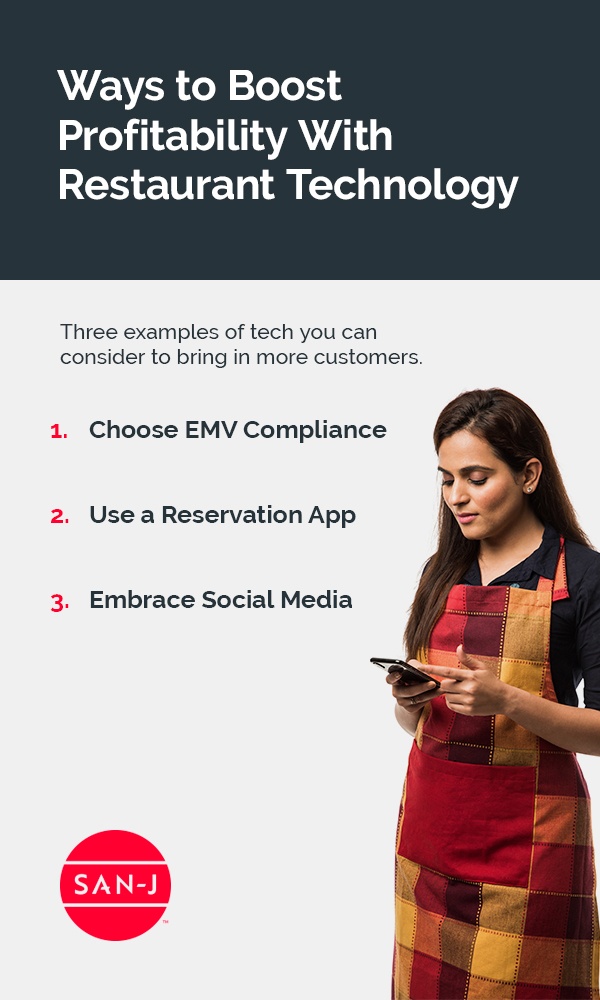
While increased profitability comes with better customer service, you can also use tech specifically to boost your revenue. There are many ways to implement platforms and services to see more sales for your restaurant. Here are three examples of tech you can consider to bring in more customers.
1. Choose EMV Compliance
EMV capabilities now enable customers to pay via credit or debit with the chip instead of the magnetic strip. The process of switching on the EMV may be a little time-consuming, but it can reduce potential credit card scams. Incorporating EMV will benefit your customers by reducing the threat of fraud, and restaurants must comply with this restaurant technology to bring satisfaction to customers. It’ll also benefit restaurant owners, as fraud reduction makes the establishment safer and more comfortable for the customers, making them want to return.
2. Use a Reservation App
Gone are the days when customers stood in long lines for their turns. The modern customer now expects to make a reservation at their favorite table online. Using restaurant reservation apps will make the booking process convenient for customers, and customers will be more likely to choose your restaurant. After all, many young customers want to give their business to establishments on the cutting edge of technology.
3. Embrace Social Media
Social media is one of the most valuable tech tools restaurant owners can use. Creating profiles on social media platforms like Facebook, Twitter and Instagram will attract attention, urging customers to either order online or drop by for a visit. It’ll allow them to know about the restaurant before visiting it, too. With social media, restaurant owners can also create personalized marketing strategies and attract their targeted customers.
Additionally, you can use these platforms to share key information with your customers. Business owners can create posts about discounts and exciting events to grab the audience’s attention and increase sales. Managers can track engagement with each post and determine what interests customers, which allows them to adjust business practices as needed to boost revenue.
For example, if you find that your posts about Thursday happy hours gain a lot of traffic, you can put more time into promoting that specific event. Restaurants that have yet to find a solid customer base can especially benefit from social media. However, this version of technology for restaurants will only work if you or your employees put enough time and effort into it.
Explore SAN-J’s Range of Products for Your Restaurant Today
Technology has become one of the principal factors in the restaurant business — but something that’s always remained the same is quality food. At SAN-J, we supply delicious Asian food products, including our Tamari Soy Sauce, for consumers and businesses around the world. We offer many non-GMO and gluten-free products, so you can serve a variety of customers in your restaurant no matter what you’re serving. Whether your chefs need to grill or marinate different menu items, our sauces taste delectable in a variety of applications. When you’re using new tech to wow new and repeat customers, you can rely on us to add a little sparkle to your menu that helps you leave even more of an impression. If you’re interested in how we can help your establishment, contact us today to learn more!
Back to Top

